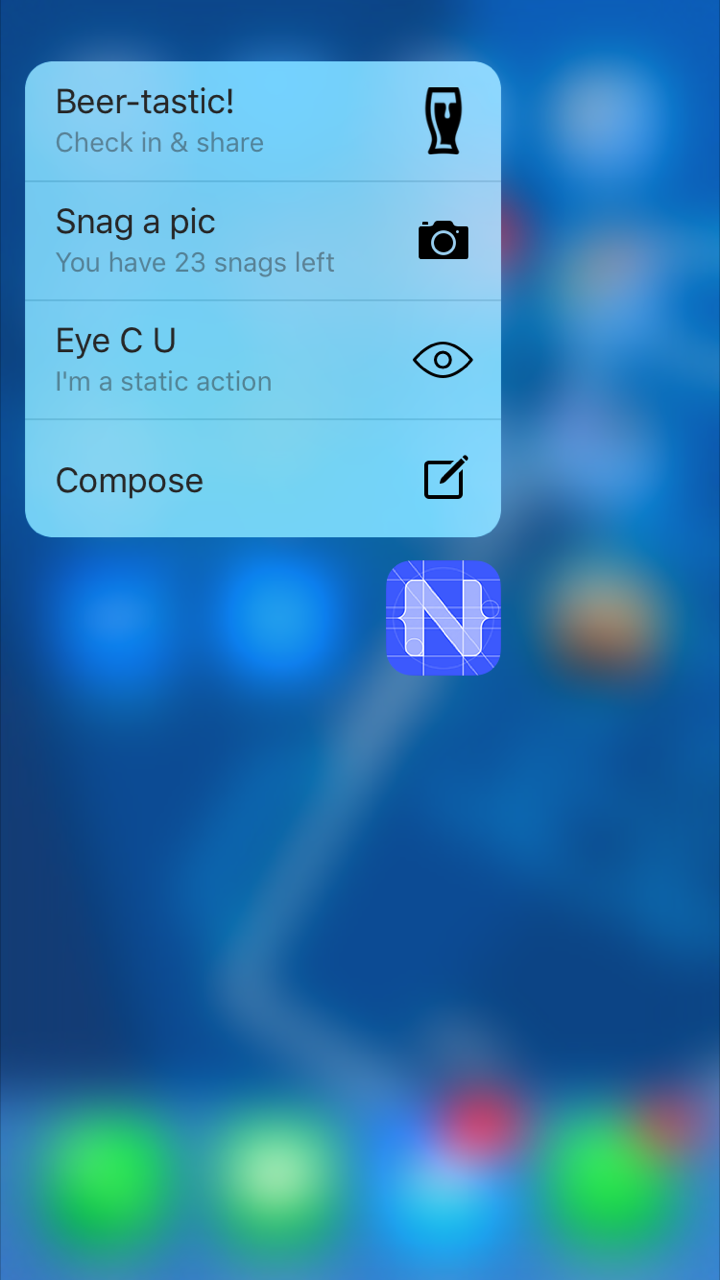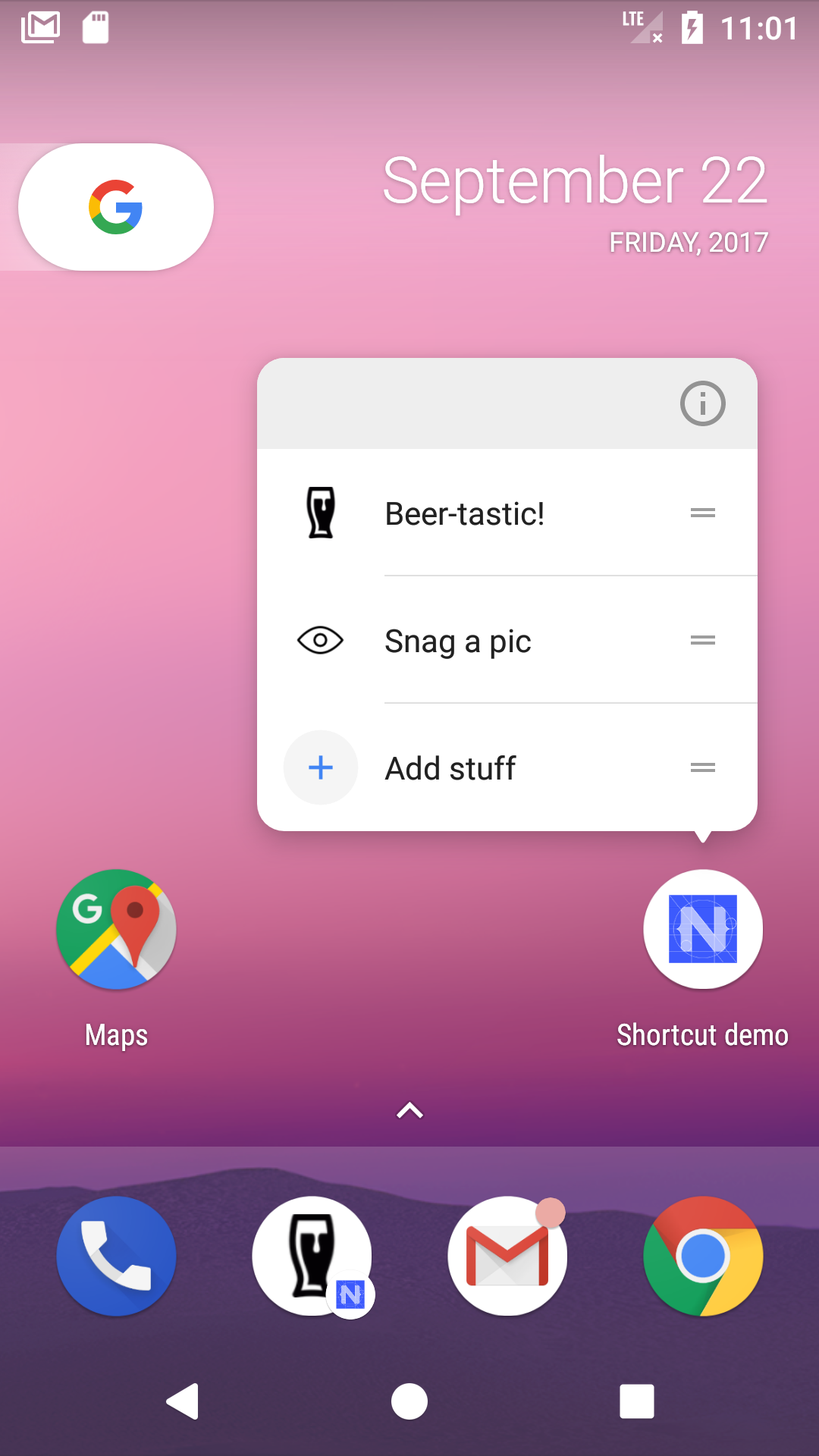- Version: 1.0.1
- GitHub: https://github.com/hsz1273327/nativescript-app-shortcuts
- NPM: https://www.npmjs.com/package/ns-shortcuts
- Downloads:
- Last Day: 0
- Last Week: 0
- Last Month: 0
NativeScript Icon Shortcuts plugin
A fork for EddyVerbruggen/nativescript-app-shortcuts


Supported platforms
- iPhone 6s / 6s Plus or newer, running iOS 9 or newer.
- Android 7.1 (API level 25) or newer.
Features
- remove
configureQuickActions(actions: Array<QuickAction>): Promise<void>,force on static shortcuts - use deeplink in
android:datain android instead ofandroid:targetClass, useandroid:targetClassnow in nativescript will throw system error
Installation
From the command prompt go to your app's root folder and execute:
ns plugin add ns-shortcutsAPI
If you want to set static shortcut, you should first check if the device can support shortcut by api available(): Promise<boolean>.then you can declear the shortcuts in app/App_Resources/<platform>first then regist the callback.
iOS config
You need to manually edit the .plist.
Fortunately NativeScript allows you to change this file through app/App_Resources/iOS/Info.plist. Anything added there is added to the final .plist during a build.
Note that dynamic actions will never replace static actions, so if you have two static actions you can add up to two dynamic ones. Any more will be ignored.
Here's an example which you can paste anywhere in the .plist file:
<key>UIApplicationShortcutItems</key>
<array>
<dict>
<key>UIApplicationShortcutItemIconFile</key>
<string>eye</string>
<key>UIApplicationShortcutItemTitle</key>
<string>Eye</string>
<key>UIApplicationShortcutItemSubtitle</key>
<string>Awesome subtitle</string>
<key>UIApplicationShortcutItemType</key>
<string>eye</string>
</dict>
</array>A few notes:
-
set shortcuts as dict item in the array.(you can add more if you like)
-
UIApplicationShortcutItemIconFile.The second action above uses the built-inUIApplicationShortcutIconTypeComposeicon, but the first one uses a custom icon:eye. This expects the fileapp/App_Resources/iOS/eye.png. According to Apple's docs this needs to be a single color, transparent, square,35x35icon - but that size will look pixelated on retina devices so go ahead and use a70x70or105x105icon if you please. -
UIApplicationShortcutItemTitle.The title of the shortcut. -
UIApplicationShortcutItemSubtitle.The subtitle of the shortcut. -
UIApplicationShortcutItemType.The payload message which will send to the application when clicked the shortcut. It will set as thetypeparam ofconfigureQuickActionsof the callback.
Android config
-
Open
app/App_Resources/Android/AndroidManifest.xmland add:<activity ..> <!-- your existing NativeScript activity -->
<meta-data android:name="android.app.shortcuts"
android:resource="@xml/shortcuts" />
</activity> -
Open
app/App_Resources/Android/src/main/AndroidManifest.xml, setdeeplinking<activity ..><!-- your existing NativeScript activity -->
...
<intent-filter>
<action android:name="android.intent.action.VIEW" />
<category android:name="android.intent.category.DEFAULT" />
<category android:name="android.intent.category.BROWSABLE" />
<!-- url started with `myapp://` will work -->
<data android:scheme="myapp" />
</intent-filter>
</activity> -
Add the file you referenced in
AndroidManifest.xml:/app/App_Resources/Android/src/main/res/xml/shortcuts.xmland add:<shortcuts xmlns:android="http://schemas.android.com/apk/res/android">
<shortcut
android:shortcutId="eye"
android:enabled="true"
android:icon="@drawable/eye"
android:shortcutShortLabel="@string/shortcut_short_label_eye"
android:shortcutLongLabel="@string/shortcut_long_label_eye"
android:shortcutDisabledMessage="@string/shortcut_disabled_message_eye">
<intent android:action="android.intent.action.VIEW"
android:data="myapp://shortcut.type.eye" />
<categories android:name="android.shortcut.conversation"/>
</shortcut>
</shortcuts>
A few notes:
-
This adds 1 static
shortcutto your app (you can add more if you like). -
android:shortcutIdis the id of certain shortcut. -
android:iconset the icon, in this example, you can dropeye.pnginto/app/App_Resources/Android/src/main/res/drawable-nodpi/. -
android:shortcutShortLabel,android:shortcutLongLabel,android:shortcutDisabledMessageis the shortcut's copywriting,you can set them inapp/App_Resources/Android/src/main/res/values/string.xml -
intentdeclear the action when click the shortcut.android:actionmust beandroid.intent.action.VIEW,android:datamust use the scheme you defined in step 2,and the hostname must started withshortcut.type.as prefix.The value behind the prefix is the equivalent of the iOSUIApplicationShortcutItemType -
categories android:namemust beandroid.shortcut.conversation
regist callback
use API setQuickActionCallback(callback: (data: LaunchQuickAction) => void): void to regist callback for shortcuts.
The ShortcutItemType will in LaunchQuickAction.type. You can use it to route to the certain page.
-
app.tsimport { AppShortcuts } from "ns-shortcuts"
import { router } from "~/router/router"
...
let appShortcuts = new AppShortcuts()
...
appShortcuts.setQuickActionCallback(shortcutItem => {
console.log(`get QuickActionCallback`)
switch (shortcutItem.type) {
case "eye":
{
setTimeout(() => {
router.push("/page1", {
frame: "main-frame"
})
console.log(`get shortcutItem.type eye`)
})
}
break;
case "beer":
{
setTimeout(() => {
router.push("/page2", {
frame: "main-frame"
})
console.log(`get shortcutItem.type eye`)
})
}
break;
default:
{
setTimeout(() => {
router.push("/", { frame: "main-frame" }),
console.log(`get unknown shortcutItem.type ${shortcutItem.type}`)
})
}
break;
}
})
A few notes:
-
if you want to use this plugin with router-vue-native or other router programme based on manual-routing, you'd better use only one Frame Only on the root node. Otherwise there will get
java.lang.RuntimeException: Unable to resume activityerror on android. -
route to a page need to set in
setTimeout(() => {route code}). Otherwise there will get error.